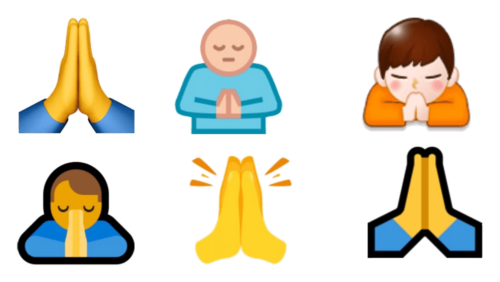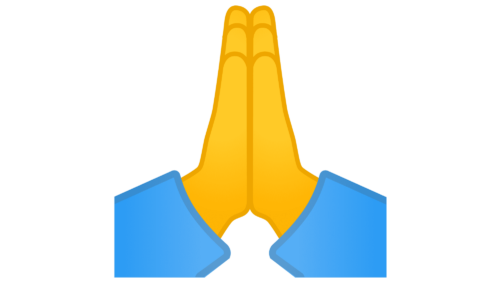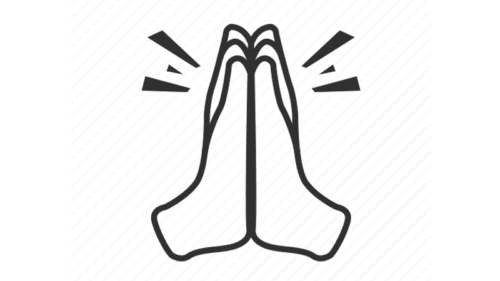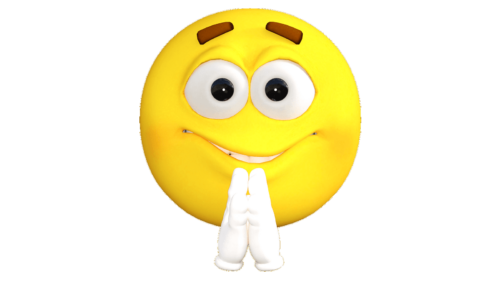Today emojis are an integral part of correspondence and there is no person who does not use them. While the meaning of some is obvious at a glance, some signs cause confusion and often people use them in the wrong context. One such emoji is the folded arms.
In Japan, this symbol is used in place of the words “please” and “thank you” and in the rest of the world mainly as a symbol of prayer. Recently, however, there has been frequent discussion that it is actually two hands giving each other a high five.
The folded hands emoji was added to the Unicode 6.0 character set in 2010 under the name “Man with folded hands”, and then was included in the Emoji 1.0 emoji set in 2015.
Meaning of the Praying Emoji
The Daily Mail conducted a study that found that only 1 in 5 people can interpret emoji correctly. And “Folded Hands” is on the list of emoji that confuse people.
For some people, the boat-folded palms conjure up images of Italian painters and Catholic prayer. So they add them to give their message a meaning like “I beg you.” In fact, this emoji originated from the Japanese habit of folding the palms of the hands as a sign of gratitude. So it’s not really a plea, but the usual equivalent of the words “Thank you” or “You’re welcome”.
In addition to religious or spiritual meanings, the folded hands emoji can be used as a gesture of compassion, support, or greeting. It can be an expression of solidarity, respect, and good cheer. In the context of communication, it can mean that the user wants to show their care and consideration for others.
It is worth noting that the meanings of the symbol can vary depending on cultural and regional differences. For example, in some countries, folded hands may mean a blessing, while in others it may simply mean a greeting or congratulation.
We cannot ignore the fact that Japan is the birthplace of emoji. And in this country, the gesture with folded hands is traditionally made before eating and is accompanied by the phrase “itadakimasu”, literally meaning “I humbly accept”. It’s analogous to “bon appetit.”
However, this emoji was originally intended as a high-five, so many people use it in correspondence in that sense. The revelation that it is more correct to look at a popular symbol from a slightly different angle has been appearing in social networks from time to time over the past few years, each time causing great excitement and controversy.
The Use of the Praying Emoji
Emoticons have long and firmly occupied their niche in modern communication: they help to express emotions in correspondence with numerous messengers. And even more: emojis are used to make sophisticated jokes, send secret messages, and even tell whole stories without a single printed word. Despite the fact that most of the faces have long been familiar and actively used, some emoji can be understood in different ways. The palms leaning against each other is just one of those: some believe it’s a prayer, while others believe it’s a high-five.
There is speculation that this emoji was created so that the user could express gratitude. The Japanese use the “Folded Hands” emoji to ask for forgiveness from the person they are talking to. One of the meanings of the emoticon is an insistent request. A request to do something, to reply, to pay attention to a comment, and the like. Sometimes, if we really ask someone for something, we just fold our hands in a similar way, complementing our request with a tone of voice and such a gesture.
It all depends on the country. For example, in Japan, this gesture is used to apologize to the interlocutor, and in the USA it is used to “give a high five”. Differences arose due to the fact that in the version of this emoticon for iOS (Apple devices) only the hands are visible, but there is no continuation. However, on some devices, we can still see the emoji in more detail, and there we can see that it is a person with folded arms.
An emoji with palms folded together can also express a respectful greeting or symbolize a display of adoration, and devotion.
In Japanese tradition, two hands folded together means an expression of gratitude, which corresponds to the expressions “please” or “thank you”.
In India, palms folded together have been a sign of respect since ancient times. This gesture was called “Anjali Mudra”. In its meaning, it is similar to the greeting gesture “namaste”. The essence of namaste is to express one’s respect for a person, gratitude, or simply a greeting.
Conclusion
If you decide to use an emoticon in correspondence, which looks like palms leaning against each other, then you must first understand its interpretation. And here there is some complexity, because users from different countries interpret the meaning of the image in their own way. It turns out that the emoticon has several meanings, and we have to choose the most appropriate one when using it, so as not to get into a mess.
The first meaning is prayer, as the folded hands look like a prayer position. The second possible meaning of the image means gratitude for something. The third interpretation is related to the American high five.
The most common interpretation is a tearful request, and the smiley in this case should be perceived as begging. I think this interpretation is the most common among our users. You can insert this mini-picture in those cases when you address to your interlocutor with a request, or you beg a person to forgive you, or you ask a person to help you.










